I. INTRODUCTION
People are increasingly encouraged to make various purchases through mobile applications to simplify daily life due to the accelerated pace of life [1-4]. The delivery market is transforming through mobile technologies [5-6]. Mobile food delivery services refer to services in which customers order food online and restaurants deliver it to them [7]. Customers can order food anytime, anyplace from a variety of restaurants conveniently comparing menus, prices, and other customer reviews [8-9]. The simplicity, accuracy, and speed of usage of online services have led to prior research showing that most individuals prefer to use food delivery applications [10-12]. According to the Korean Consumer Agency, the number of mobile food delivery application users is steadily increasing every year and reached 25 million in 2018 [13].
Generally, after arriving in South Korea, foreigners suffer various problems such as isolation, language barriers, cultural differences, and other difficulties that significantly impact their everyday lives. Most of them are either unskilled in Korean or have a limited understanding of it; therefore, they also often have difficulties when they order food using menus in Korean. Particularly in small towns and rural areas, restaurants in most cases do not have English-speaking staff or do not provide menus in English. Consequently, foreigners order food using mobile applications. However, the information in English that is provided in mobile food delivery applications is usually condensed, which can cause inconveniences in their use.
The most important criterion of any service platform for increasing the number of consumers is ‘convenience’. Mobile applications are utilized less frequently if the user has difficulties using them [10-11]. Therefore, the purpose of this study is to propose a design upgrade for a mobile food delivery application in English that would be efficient, simple, and contain all the information that foreign users residing in South Korea need.
This study was conducted by examining the basic requirements of foreigners for mobile food delivery applications. Based on the problem statement, two research questions are further defined as:
-
- What difficulties do foreign users face when they use mobile food delivery applications in South Korea?
-
- What features should be added to mobile food delivery applications in South Korea?
During this study, respondents noted that when using food delivery applications, the most inconvenient aspects were the lack of an English language option and the insufficient amount of necessary information in the application interface.
The placement of particular user interface elements other than pre-designed ones, which we added as part of the user interface design improvements, improves the quality of its perception, and therefore its usability. Besides, while improving the interface design, we added aspects that were previously missed in the interface of the mobile food delivery application. The results of this study may benefit developers of new food delivery applications that are more suitable for foreigners to facilitate food adaptation in a foreign country.
This paper is structured as follows. In Chapter 2, a theoretical background was presented by examining research related to mobile food delivery application case studies, foreign residents statistics in South Korea and dietary acculturation. In Chapter 3, research models, and data collection and analysis methods were explained. In Chapter 4, statistical analysis was performed. In Chapter 5 a new interface design version of food delivery application was suggested. Chapter 6 presents conclusion.
II. LITERATURE REVIEW
In the modern world, users can quickly find restaurants nearby using mobile food delivery applications [14]. Forease of use, the process of creating an account, ordering, paying and delivery is getting simplified [15].
With the outbreak of the Covid-19 pandemic in South Korea, the number of people ordering food via mobile devices has steadily increased. According to Korean news reports, the number of people using food delivery apps increased by 78% in the first quarter of 2021. Various mobile applications are used to order food, but the most popular are “Baemin”, “Yogio”, “CoupangEats” and “Shuttle”. The number of people who used the food delivery applications has surpassed 16 million [16].
Table 1 presents the main characteristics of mobile food delivery applications in South Korea. The most popular app among these is “Baemin”, which has 9.35 million monthly users [16]. More than 140,000 restaurants have registered on this platform. The “Baemin” operates only in Korean, and it is necessary to create an account via e-mail. This application is available in all provinces of South Korea [17]. “Yogio” is the next in popularity, with 5.34 million users per month [16]. “Yogio” application is also entirely in Korean. To place an order, users must create an account via e-mail. Similar to “Baemin”, “Yogio” is also available throughout South Korea [18]. “CoupangEats” is a relatively new food delivery app with around 990,000 monthly users [16]. Since the Coupang delivery service has developed this food delivery app based on the online store, users are familiar with the ordering functions. The advantage of this mobile application is the English translation function. But unfortunately, “Coupang Eats” does not work in all areas of South Korea [19]. The Shuttle app is one of the most popular among foreigners [16]. This application is available in English and Korean and was developed for foreigners. Therefore, the account creation and food order processes are simplified. This application is used in areas with large number of foreign residents: Seoul (Nsang-gu, Gangnam-gu, Seocho-gu, Sodaemun-gu, Mapo-gu, and Jung-gu), Pyeongtaek, and Busan [20].
Korea ranks first in the word for food delivery service [16].
South Korea is one of the most visited countries in the world. The number of visitors is growing every year. Most of them are students, teachers, professors, marriage migrants, and tourists. According to the Ministry of Justice statistics, the number of foreigners visiting South Korea increased from 26 million to 35 million from 2017 to 2019. However, many foreigners left South Korea due to the rapid outbreak of Covid-19, while others have been unable to enter due to border closures for tourists. Therefore, the number of foreigners who arrived in 2020 amounted to just 5 million people and around 2 million in 2021 (Table 2) [21]. From September 1, 2021, the South Korean government has lifted restrictions on tourists visiting the country, therefore, the number of foreigners began to increase again [21]. Considering the status of foreigners by main nationalities, the leaders are Chinese (42.9%), followed by Vietnamese (10.7%), Thai (8.8%), American (7.2%), and Uzbek (3.4%) (Fig. 1) [21].
Moj immigration statistics [21].
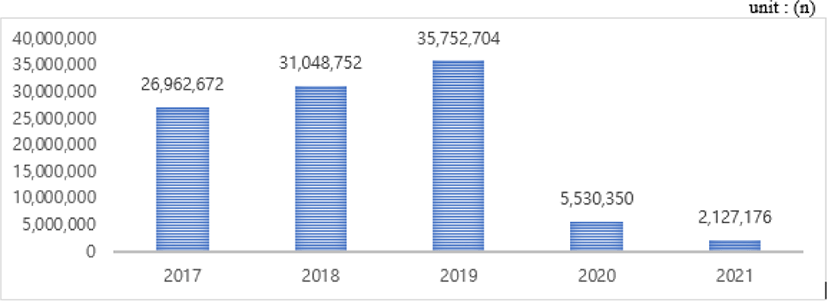
Acculturation is a cross-cultural adaptation process that integrates different cultural adjustments, behaviors, and acceptance of one’s identity [22]. According to Park (2009) [23], acculturation is socialization and integration whereby, as human groups, people instinctively integrate into their environments and social structures to collect the traditions, languages, etc., essential for social life. Corsini and Auerbach (1996) [24] consider acculturation to be the process by which a person adopts certain social norms and exerts an enduring influence on these customs throughout his life, not just for a certain period. According to Lee and Hwang (2008) [25], acculturation is a part of the nature of humans that ideally adapts to a variety of social contexts where there are disparities between external, social, and physical variables, psychological needs, and the internal and external world of humans. Redfield et al. (1936) [26] characterized acculturation as the process of migration changes that occurs when two or more cultures interact in a host country.
New changes in life are provided to immigrants by accepting the culture of a new nation, but at the same time, the foreigners lose their identity and integrity, which makes it harder for them to face challenging circumstances [27]. According to Berry et al. (1987), acculturation stress is caused by dietary, climatic, and psycho-cultural differences [27]. Park and Lee (2012) convince that acculturation stress is related to immigrants’ challenges when assimilating into a new culture [28]. These problems are caused by linguistic and cultural barriers, social conventions, and financial dif-ficulties [29].
The most significant cultural difference for immigrants in South Korea was food culture, they had difficulties in adapting to Korean eating habits [30-31]. Consequently, Korean society must help the immigrants to adapt to the Korean cuisine [32]. Due to the close relationship between migrant lifestyle and diet, which has an impact on their health, diet adaptation is crucial [32-34].
Dietary acculturation, which is a complex and dynamic process that affects the development of eating habits in a new context, was named by Colby, Morrison, and Haldeman as the term for changes related to eating habits and dietary patterns [35-36]. Acculturation has always been associated with the process of food selection because food strongly influences the psychosocial adaptation of migrants [36]. The process through which migrants adapt to the dietary customs of a new environment is considered dietary adaptation [37]. That is affected by various factors, including fluency in a new language, educational attainment, and income level that allow migrants to reside longer in a particular country [38-41]. Additionally, migrants are better able to adjust to dietary customs when they are employed [42-43].
Culture is a strong circumstance that determines which food will be suitable from their point of view [44]. Culture strongly impacts food choice preferences, influenced by the environment, beliefs, social and family practices, and political and economic systems [45-46].
III. METHOD
The survey was conducted among foreigners aged 20 to 60 living in Busan, South Korea, who had experience in ordering food via mobile food delivery applicationsfrom March 5 to March 18, 2022, using Google Forms online survey method. A total of 64 responses were collected, and after excluding 17 incorrect or incomplete answers, 47 completed questionnaires were used as data for the final analysis.
The study used a quantitative research method. The questionnaire consisted of 14 questions (Table 3).
Questions 1–7 relate to general information, question 8 relates to the types of food delivery apps, question 9 relates to the frequency of use, questions 10–13 relate to the app interface, and question 14 relates to the points to improve.
Data of this study were analyzed using the statistical program SPSS (version 21.0). Frequency analysis was used for organizing and summarizing the data from the survey. Frequency analysis is a method of data analysis used to determine the features of gathered data. It evaluates the outline characteristics, such as the frequency of variables and the distribution of central tendency values and analyses the raw data’s distribution status [47].
IV. RESULTS
The analysis indicated the total responses of participants (for each group) to the questions included in the survey. The results of summary statistics are shown in the tables below along with corresponding figures.
26 female foreigners (55.3%) and 21 male foreigners (44.7%) among 47 respondents from different countries participated this survey: 13 from China (27.6%), 9 from Vietnam (19.1%), 3 from Thailand (6.4%), 18 from the USA (38.4%) and 4 from Uzbekistan (8.5%). According to the age, 45.1% are from 20 to 30 years old, 46.5% from 31 to 40 years old, 4.2% from 41 to 50 years old and 4.2 % from 51 to 60 years old. 11 (23.4%) respondents have a beginner level of Korean, 9 (19.1%) elementary, 10 (21.3%) intermediate, 12 (25.5%) advanced and 2 (10.7%) proficient levels. The number of respondents who have lived in South Korea for less than a year is 2 (4.3%), 1–2 years 5 (10.6%), 3–5 years 12 (25.5%), and more than 5 years 28 (59.6%). By occupation, 21 (44.7%) are students, 15 (31.9%) teachers/ professors, 6 (12.8%) office workers, and 5 other professions (10.6%). By religion, 19 (40.4%) are Christians, 2 (4.3%) Muslims, 23 (48.9%) do not identify themselves with any religion, and 3 (6.4%) are followers of other religions (Table 4)
Table 5 represents statistics on the type of food delivery apps, usage frequency, app interface, and points to improve. The first section is about the types of food delivery apps: the most popular food delivery app is “Baemin” preferred by 26 (55.3%) respondents; 11 (23.4%) respondents chose “Yogiyo”, 10 (21.3%) respondents chose “Coupang Eats” and only 3 (6.4%) of respondents used “Shuttle”. The next section is usage frequency: food ordering via mobile applications is carried out 1–4 times a month by 14 (29.8%), 5– 9 times a month by 20 (42.6%), and more than 10 times a month by 13 (27.6%) respondents. The third section contains questions about the application interface. Regarding
the satisfaction of using the interface of mobile delivery apps, 25 (53.3%) respondents indicated it satisfactory for them, 17 (36.2%) respondents claimed it not satisfactory, and only 5 (10.6%) respondents remarked it absolutely satisfactory. 29 (61.7%) respondents admitted that language options are the most uncomfortable point while using the app, 11 (23.4%) respondents also chose application inter
face and 7 (14.9%) responds chose usability. 33 (70.2%) of respondents indicated that they preferred to use applications in English, while 14 (29.8%) preferred Korean. When it concerns translating the names of dishes, among the respondents who chose English option, 29 (87.8%) respondents preferred the full translation, while only 4 (18.2%) respondents preferred to see the transcription of Korean names in English. 23 (48.9%) respondents remarked that the food delivery app was not user-friendly for people with medical or religious restrictions, 18 (38.3%) stated that the application was not user-friendly at all, and only 6 (12.8%) respondents thought it was user-friendly. The last section is
concerned with points to improve. According to the responses, 13 (27.6%) people would like to add information about calories and nutrition. 10 (21.2%) people noted that it is worth adding a language option. In addition, 10 (21.2%) respondents would like to add information about the food description, and the food preparation method. 9 (19.1%) people noted that is important to include information about allergens. Furthermore, 7 (14.9%) people mentioned to include information about the restrictions of any religion, including 4 (8.6%) people who marked vegetarianism and 3 (6.4%) people who marked halal food. 6 (12.7%) people indicated that the ingredient origin should be added, 5 (10.7%) people noted that it is also worth adding information about the pungency level. 2 (4.3%) people indicated the need to include foreign cards for payment, and one person per category (2.1%) indicated a need for information on portion size, the strength of alcohol, types of packaging, compliance with hygiene standards and requirements, delivery times and exclusive benefits for VIP users.
V. DESIGN SUGGESTION
This survey was conducted with a group of foreigners who had experience in using South Korean food delivery applications. Based on a survey, we proposed a new interface information design version for the “Baemin” application. The improved design is as follows (Table 6), (Fig. 2).
We translated the application interface and the name of ‘돼지김치찜’ as ‘Stewed Pork and Kimchi’, not as ‘Dwaeji Kimchi Jjim’. If the dish name is transcribed in English, it can be difficult for foreigners who are not familiar with Korean the dishes into English. As shown in Fig. 3, we trans-lated language and culture to understand the meaning of the dish name unless it is a globally known dish such as kimchi, bibimbap, or bulgogi.
According to the survey result, a large number of respondents would like to add a pungency indicator, the dietary restriction certificates for religious or medical reasons. Hence, we added information on pungency, allergens, nutritional value, and ingredients origin.
Not all restaurants represented on “Baemin” provide information about food allergens, consequently, there is a risk for people with allergies. Even if such information is provided, users need to refer to the menu description section to find the information about the ingredients of the dish they want to order, that is not convenient. Therefore, we propose to make an ‘allergen’ icon at the top of dish name on the order screen to help users easily identify whether the dish has allergens. As shown in Fig. 4 ‘allergen’ icon is designed using the mint color, the corporate color of “Baemin”. When the relevant icon is touched, the allergen list appears. We also put the exclamation mark on the icon to signify caution.
As more and more people are concerned about their health, the demand for nutritional information has also increased. We tried to satisfy the needs of users by adding nutritional information that was not previously available. Nutritional information is placed just below the dish description, as shown in Fig. 5. When the icon is touched, a screen appears from the bottom up and users can easily check the related information. For the nutrition information icon, we also used the mint color, the corporate color of “Baemin”. This section also contains information on carbohydrates, proteins, and fats.
In the existing application, the information about ingredients origin is located at the bottom of the menu screen. It is possible to check it by scrolling the menu, but it is inconvenient for users. Therefore, we have added an ‘ingredients’ ‘origin’ icon that by clicking on, users can easily find the information about the ingredients origin that were used in the preparation of a particular dish (Fig. 6).
We have made a unified indicator for determining the dishes’ pungency level. The existing “Baemin” application does not have a unified pungency indicator, so each restaurant uses their own pungency level indicator, which is extremely subjective. However, for foreigners who are not used to spicy food, the lack of a unified indicator causes inconvenience. Based on this point, as shown in Fig. 7, we marked the pungency levels with red chili pepper icons and placed these icons next to the dish name to be easily recognized.
The pungency level has been divided into 3 levels: 1 red chili pepper is mild, 2 red chili peppers is spicy, and 3 red chili peppers is hot.
Currently, “Baemin” is using the ‘Cesco’ comprehensive environmental sanitation company’s management service. It is possible to check the latest pest control inspection information using ‘info’ icon. We also suggest including information about vegan/halal certificates in the ‘info’ icon (Fig. 8).
In addition, if a restaurant has received vegan/halal food certification, the certification indicator can be placed at the top of the restaurant name.
In this study, we used the examples of the Korea Agency of Vegan Certification and Services and the Korea Muslim Federation Halal Committee certifications (Fig. 9).
Currently, “Baemin” displays vegan/halal food in a self-correcting manner as shown in Fig. 10(a). In the menu on the restaurant page, the popular dish is marked with ‘best’ sticker. Therefore, we propose to use similar stickers for the vegan/halal food. As shown in Fig. 10(c), for vegan food we suggest using yellow green leaf shape sticker that symbolizes plants and nature, and for halal food, the already existing ‘halal” sticker. Once the vegan/halal food information is unified, it will be easier for users to identify it (Fig. 10(d)).
VI. CONCLUSION
In this study we suggested a design improvement for an existing “Baemin” food delivery application, which would be more functional for foreigners living in South Korea.
Considering that a lot of foreign users preferred the English language option, we proposed a design in English. Additionally, a lot of foreign users require more accurate information, consequently we have included indicators of pungency levels next to the dishes name. Since many foreign users pay attention to caloric information and the information about the ingredients’ origin, we clearly marked them in the application.
In addition, representatives of some religions cannot eat certain foods. In order to simplify the process of recognizing approved dishes, we have developed universal icons for vegan/halal food.
This study expands information about the difficulties of adaptation of foreigners through the example of mobile food delivery applications. The results of this study may benefit developers of new food delivery applications that are more suitable for foreigners to facilitate food adaptation in a foreign country.
This study, however, is subject to one limitation. The improvement of the interface design related to pungency, allergens, nutrition, and ingredients origin proposed in the current study requires a change in database design and establishment of necessary data in the information system. Such activities would require a large budget, therefore, we consider it necessary to conduct further research on the economic benefits of the application interface design improvement.









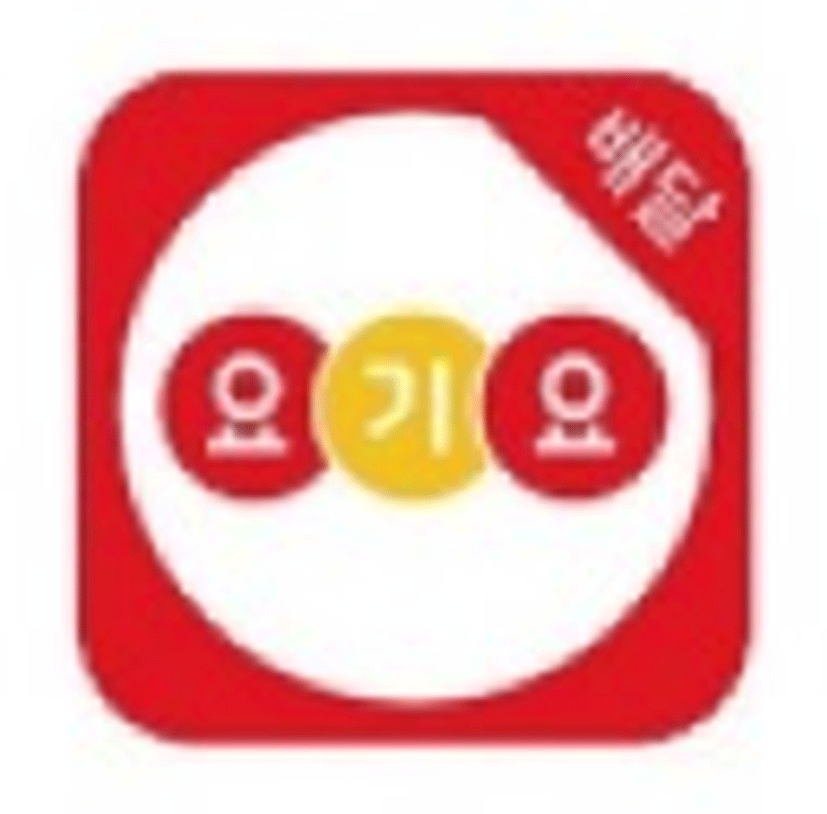


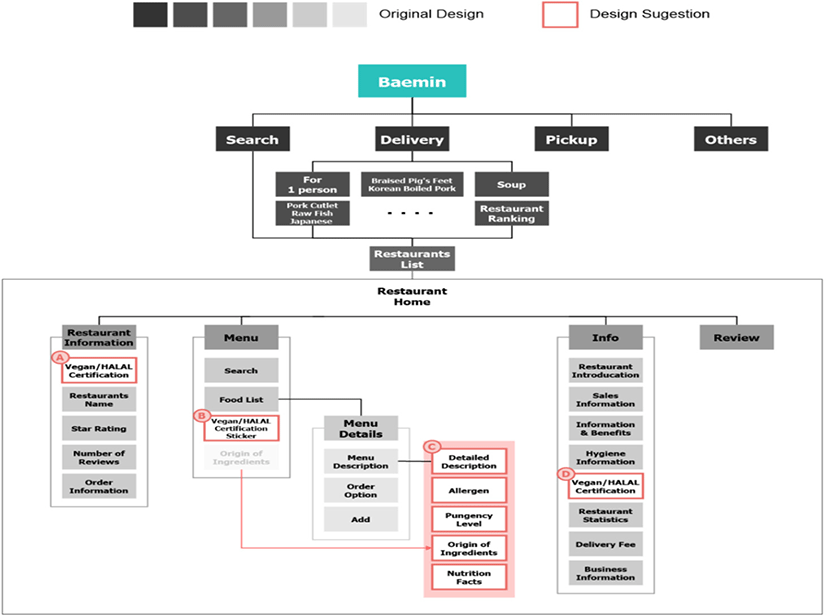
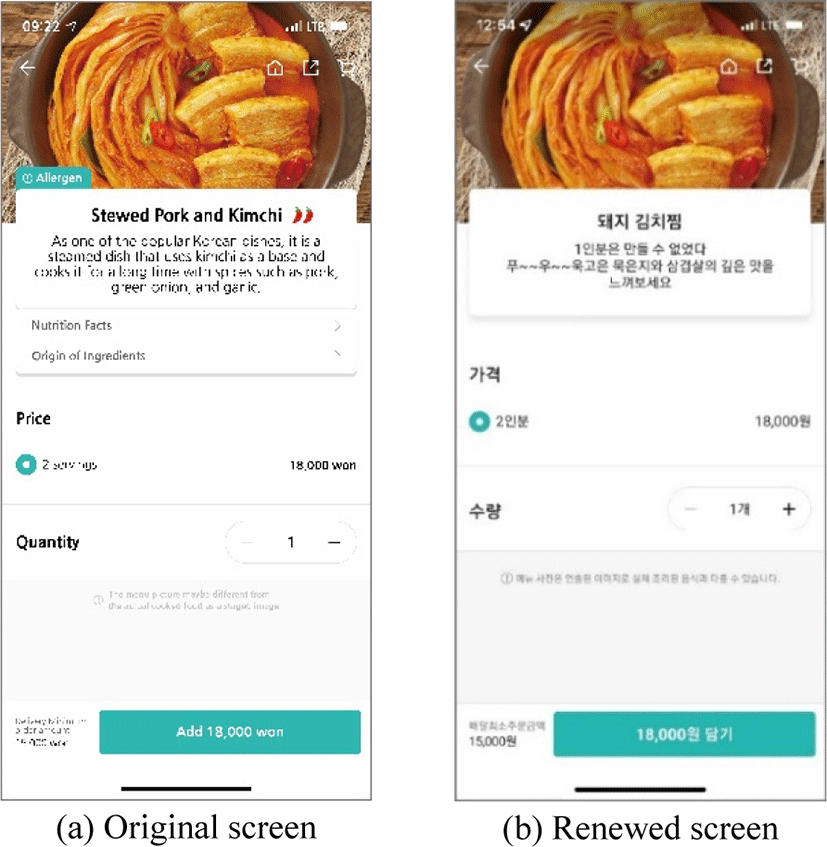
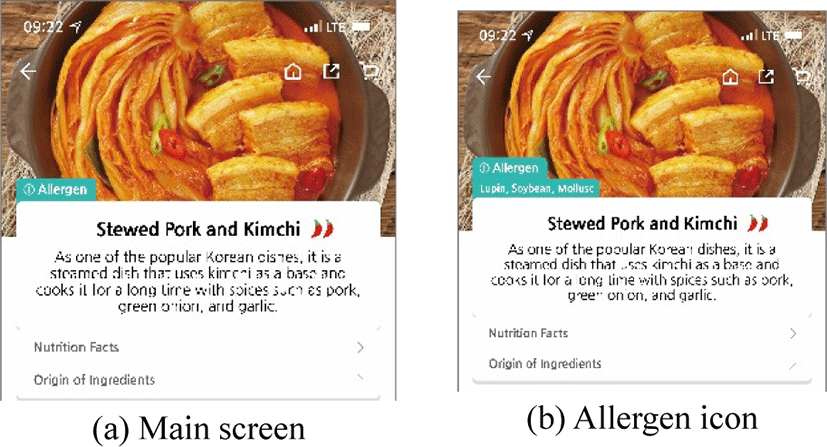
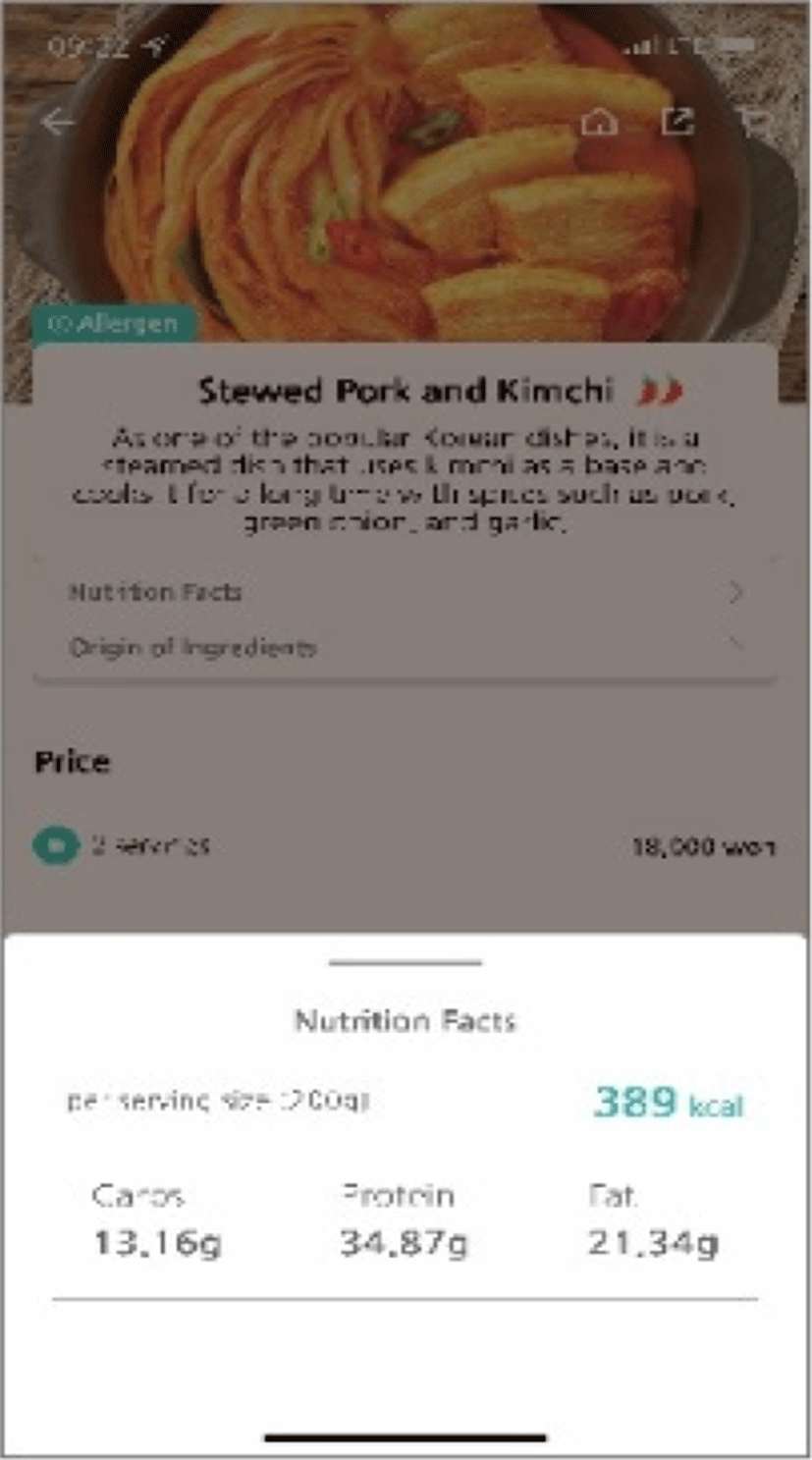
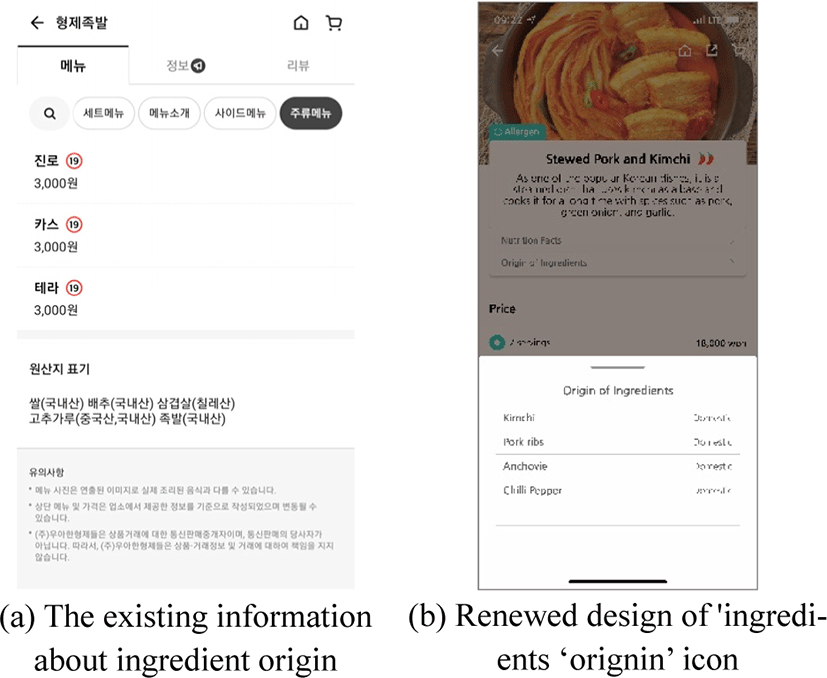
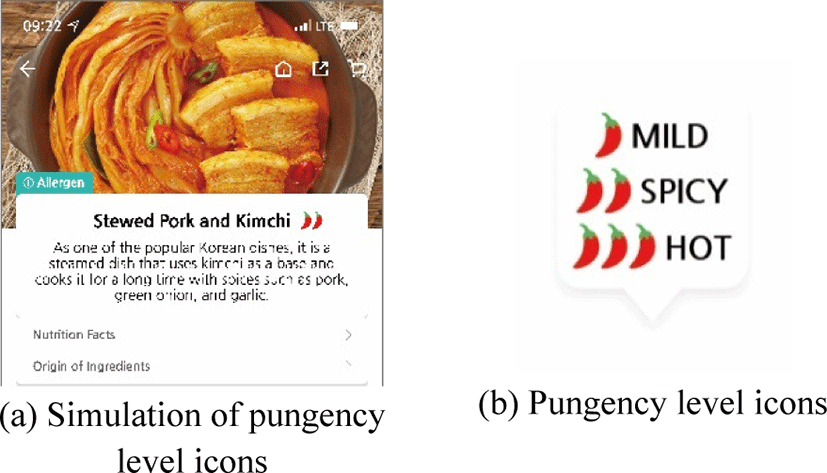
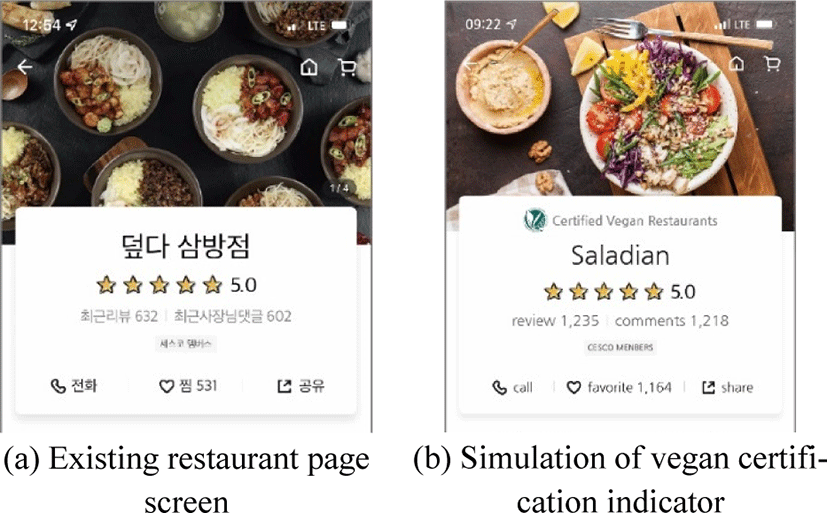
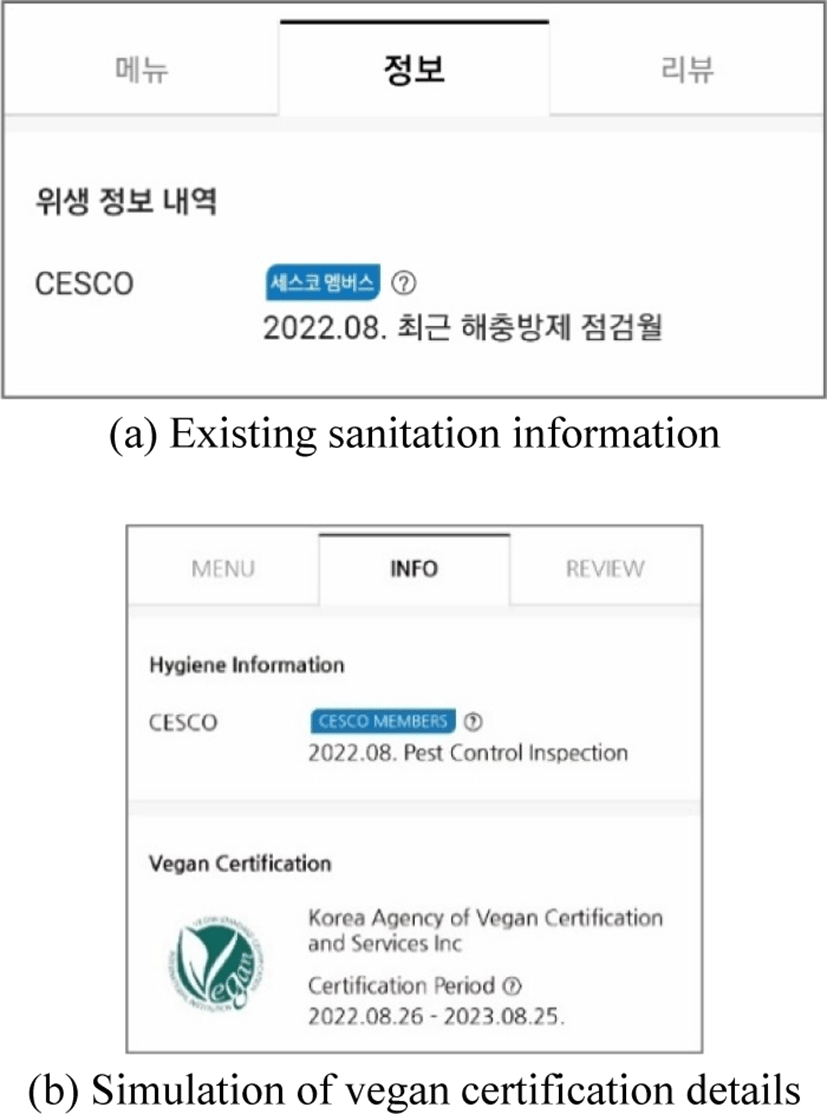
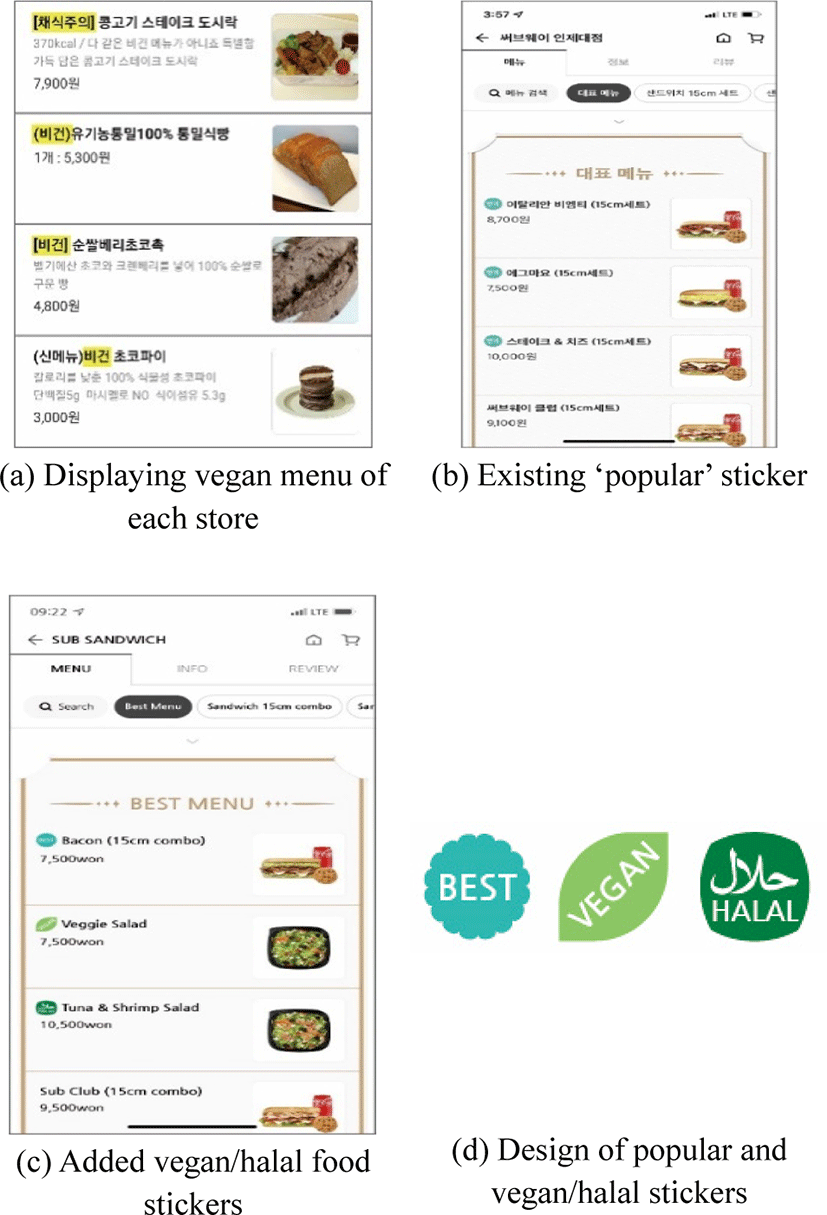
 received her BS degree in the Department of Food Engineering from KyungSung University, Korea, in 2020. In 2021, she joined the Department of U-Design to pursue her MA degree at Inje University.
received her BS degree in the Department of Food Engineering from KyungSung University, Korea, in 2020. In 2021, she joined the Department of U-Design to pursue her MA degree at Inje University. received her BS degree in the Department of Multimedia from Inje University, Korea, in 2022. In 2022, she joined the Department of U-Design to pursue her MA degree at Inje University.
received her BS degree in the Department of Multimedia from Inje University, Korea, in 2022. In 2022, she joined the Department of U-Design to pursue her MA degree at Inje University. received her BA degree in the Institute of Oriental Studies from Kazan State University, Russia, in 2008, and MA degree in the Department of Social Sciences from Beijing Language and Culture University, China. In 2021, she joined the Department of U-design to pursue her PhD degree at Inje University.
received her BA degree in the Institute of Oriental Studies from Kazan State University, Russia, in 2008, and MA degree in the Department of Social Sciences from Beijing Language and Culture University, China. In 2021, she joined the Department of U-design to pursue her PhD degree at Inje University. received her BFA degree from Kyungbook National University, Korea, in 1991. She received an MFA degree from Hongik University, Korea, in 1993, and MS degree from Pratt Institute, USA, in 1996. She received a PhD degree in the department of Visual Communication Design from Kyung-book National University, Korea, in 2012. Since 2001, she has been working as a professor at the department of Multimedia Design, Inje university, Korea.
received her BFA degree from Kyungbook National University, Korea, in 1991. She received an MFA degree from Hongik University, Korea, in 1993, and MS degree from Pratt Institute, USA, in 1996. She received a PhD degree in the department of Visual Communication Design from Kyung-book National University, Korea, in 2012. Since 2001, she has been working as a professor at the department of Multimedia Design, Inje university, Korea.